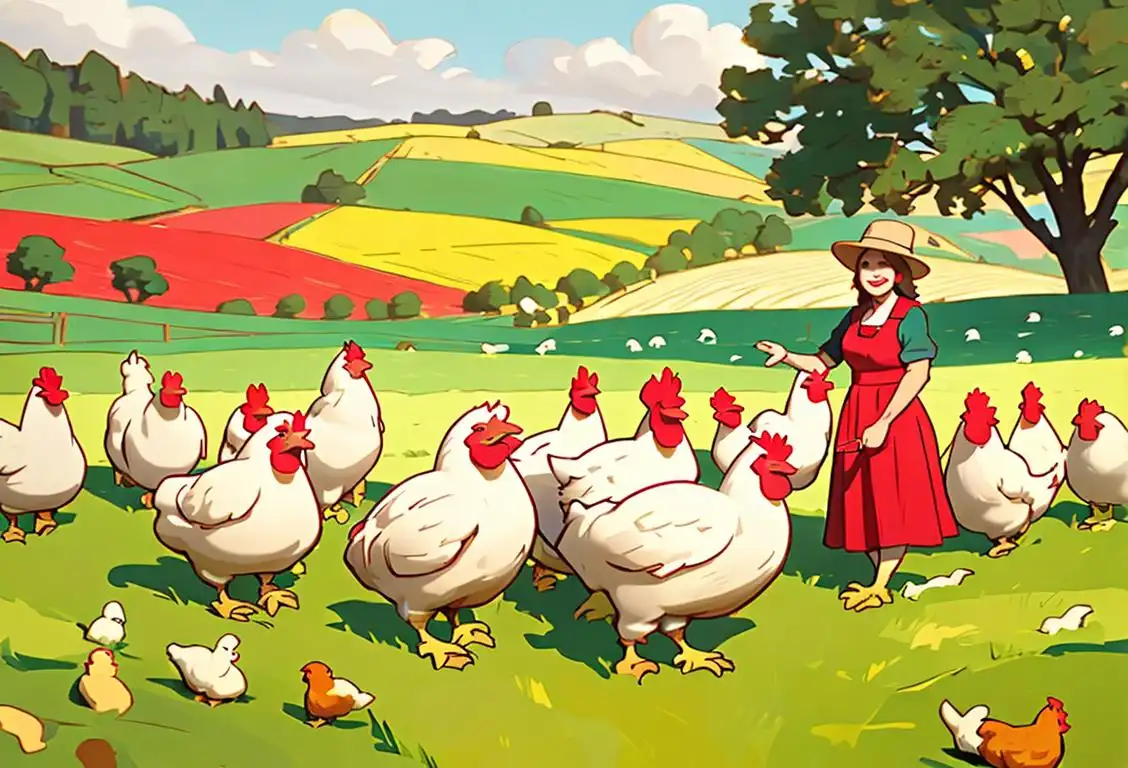National Biscotti Day

Have you ever taken a bite of a biscotti and thought, 'Wow, this delightful cookie deserves its own national day!' If so, then you're in luck because National Biscotti Day is here to satisfy all your crunchy, dunkable desires. So grab a cup of your favorite beverage and get ready to dive into the delicious world of biscotti!
When is Biscotti Day?
It's national biscotti day on the 12th February.
The Origins of Biscotti
Biscotti, also known as cantucci in Italy, have a long and distinguished history. These oblong-shaped cookies originated in the city of Prato, near Florence, during the 14th century. Back then, biscotti were the preferred treat of sailors and soldiers due to their long shelf life. The sweetness and crunchiness made them the perfect companion for long voyages and battles.
Originally, biscotti were made with just flour, sugar, eggs, and almond extract. The dough was baked twice to achieve its characteristic dry and crunchy texture. Over time, bakers started adding a variety of ingredients to enhance the flavor and experience of enjoying biscotti.
The Internet Buzz
Fast forward to the present day, and biscotti are now beloved by cookie enthusiasts worldwide. National Biscotti Day is the perfect occasion to indulge in these delectable treats and discover new flavors and combinations.
Whether you prefer classic almond biscotti, chocolate-dipped varieties, or unique flavors like lemon zest or cranberry, there's a biscotti out there for everyone. From biscotti lovers sharing their favorite recipes on social media to influencers dunking biscotti in coffee for that perfect Instagram shot, the internet is abuzz with excitement on this special day.
History behind the term 'Biscotti'
14th century
Medieval Origins
Biscotti, meaning 'twice-baked' in Italian, originated in the 14th century in the Tuscany region of Italy. They were initially made as long-lasting, hard biscuits for soldiers and sailors, as they could be stored for months without spoiling. The twice-baked process involved baking the dough twice, which resulted in a crunchy texture.
14th century
Medieval Origins
The term 'biscotti' finds its roots in Italy during the 14th century. Derived from the Latin word 'biscoctus' meaning 'twice-cooked,' biscotti were originally created as a long-lasting food staple for soldiers and travelers. This crunchy, dry cookie was an ideal ration for long journeys due to its durability.
14th century
Medieval Origins
The term 'biscotti' traces its origins back to the 14th century in Italy. The word 'biscotti' is derived from the Latin term 'bis' meaning twice and 'coctus' meaning baked. During the medieval period, Italian bakers started making a twice-baked bread as it was easier to transport and had a longer shelf life.
14th century
Origin of the term 'biscotti'
The term 'biscotti' originated in Italy during the 14th century. The word 'biscotti' is derived from the Latin term 'bis coctus,' which means 'twice-baked.' This refers to the unique baking process involved in making biscotti. The biscotti dough is first baked in the form of a loaf or a log, and then sliced into individual pieces. These pieces are then baked again to obtain their characteristic dry and crunchy texture.
19th century
Popularity of biscotti in Italy
Throughout the 19th century, biscotti gained popularity in Italy as a staple food. They were known for their long shelf life, making them suitable for long journeys and as a source of sustenance for soldiers and travelers. Biscotti's dry and crunchy texture, along with their ability to withstand harsh conditions, made them a perfect companion for coffee or wine. The combination of biscotti and a hot beverage became a cultural tradition in Italy.
17th century
Celebratory Treats
During the Renaissance period in Italy, biscotti started to gain popularity as a celebratory treat. The crunchy biscuits were often served with sweet dessert wines, such as Vin Santo, for dipping. The combination of the dry, textural contrast of the biscotti with the wine's sweetness was highly appreciated by the Italian nobility.
17th century
Introduction of Almonds
In the 17th century, almonds were introduced as an ingredient in biscotti. The addition of almonds not only enhanced the flavor but also improved the nutritional value of the crunchy bread. Almond biscotti gained popularity across Italy and became a staple in many households.
19th century
Renaissance of Biscotti
Biscotti gained popularity during the 19th century in Italy, particularly in the region of Tuscany. Pastry chefs began experimenting with different ingredients and flavor combinations, adding nuts, fruits, and spices to the traditional recipe. Biscotti became a symbol of extravagance and were often served alongside sweet wines or liquors in elegant, upper-class gatherings.
19th century
Enhanced Recipe
In the 19th century, pastry chefs began to experiment with biscotti, introducing various flavors and ingredients to enhance their taste. Nuts, anise seeds, and chocolate were commonly added to the dough, further diversifying the biscotti offerings. This gave birth to a wide array of flavors still enjoyed today.
19th century
Evolution into a Sweet Cookie
During the 19th century, biscotti underwent an evolution and transformed into a sweet cookie-like treat. Bakers started adding sugar and flavors like anise or lemon zest to enhance the taste. This shift led to the creation of what we now commonly recognize as biscotti - a twice-baked, oblong-shaped, crispy cookie.
20th century
Immigrant Influence
As Italian immigrants traveled to the United States in the early 20th century, they brought the tradition of biscotti with them. Biscotti quickly gained popularity among Americans, becoming a beloved treat. However, they were not referred to as biscotti initially; they were more commonly known as 'Italian almond biscuits' or 'Cantucci.'
20th century
Biscotti's introduction to the United States
In the early 20th century, Italian immigrants brought biscotti to the United States. Initially, biscotti was limited to Italian-American communities. However, as Italian cuisine gained popularity, biscotti became more widely known and appreciated by the general public. Biscotti appeared on dessert menus in Italian restaurants across the country and started making their way into mainstream American culture.
20th century
Global Popularity
In the 20th century, Italian immigrants brought the tradition of biscotti to various parts of the world, spreading its popularity. Biscotti became a beloved treat in many countries, particularly in the United States. Its unique texture and ability to pair well with coffee, tea, or wine contributed to its global appeal.
20th century
Biscotti Beyond Borders
In the 20th century, Italian immigrants brought biscotti recipes to various parts of the world, introducing the delights to new cultures. Biscotti quickly became beloved internationally, with their unique crunch and versatile flavorings. They became particularly popular in coffee shops, where they pair exceptionally well with hot beverages.
1980s
Biscotti Trend Takes Off
In the 1980s, biscotti experienced a renaissance in the United States. Gourmet coffee shops, influenced by the growing appreciation for Italian cuisine, started offering biscotti as an accompaniment to their beverages. The cookie's firm texture made it perfect for dipping into coffee or espresso. Biscotti became a trendy delicacy, available in various flavors and enjoyed by people of all ages.
1980s
Biscotti's international recognition
During the 1980s, biscotti gained international recognition and became a trendy treat worldwide. Their unique shape, dry texture, and versatility made them a favorite among coffee shops and cafes. Biscotti started to appear on store shelves in various flavors, including almond, chocolate, and cranberry. They became a popular accompaniment to hot beverages, especially coffee and tea, in countries beyond Italy and the United States.
Present
Biscotti as a gourmet delicacy
Today, biscotti are considered a gourmet delicacy and can be found in numerous flavors and variations. They are often enjoyed as a sweet treat or given as gifts during festive occasions. Biscotti's cultural impact extends beyond its Italian origins, and it is now embraced as a beloved cookie worldwide. Whether dunked in coffee, enjoyed with wine, or savored on their own, biscotti continue to delight taste buds and add a touch of Italian tradition to many cuisines.
Present Day
Global Delight
Biscotti has evolved into a globally recognized and beloved treat. While staying true to its origins, modern biscotti comes in an array of flavors, including chocolate, pistachio, cranberry, and more. It has become a popular gift item, and people enjoy it not only with coffee but also with tea, hot chocolate, and even wine. Biscotti continues to be a symbol of Italian culinary heritage and a delightful indulgence worldwide.
21st century
Contemporary Innovations
Biscotti continues to evolve in the 21st century, with a myriad of variations to suit different tastes and dietary needs. Health-conscious recipes incorporate whole grains and alternative sweeteners, while creative adaptations introduce unconventional flavors like lavender or citrus zest. Biscotti's international appeal and adaptability ensure it remains a beloved treat worldwide.
Did you know?
Did you know that biscotti were the preferred snack of ancient gladiators? These crunchy cookies provided them with a burst of energy before stepping into the arena. Talk about a pre-battle treat!Tagged
nsfw foodFirst identified
29th September 2016Most mentioned on
12th February 2017Total mentions
46Other days
Chocolate Mousse Day
Something On A Stick Day
Children Day
Awareness Day
Frappe Day
Taco And Vodka Day
Happiness Day
Opposite Day
One Day
Poultry Day









